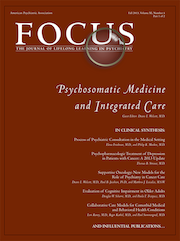Effect of Dignity Therapy on Distress and End-of-Life Experience in Terminally Ill Patients: A Randomised Controlled Trial
Abstract
Background
Dignity therapy is a unique, individualised, short-term psychotherapy that was developed for patients (and their families) living with life-threatening or life-limiting illness. We investigated whether dignity therapy could mitigate distress or bolster the experience in patients nearing the end of their lives.
Methods
Patients (aged ≥18 years) with a terminal prognosis (life expectancy ≤6 months) who were receiving palliative care in a hospital or community setting (hospice or home) in Canada, USA, and Australia were randomly assigned to dignity therapy, client-centred care, or standard palliative care in a 1:1:1 ratio. Randomisation was by use of a computer-generated table of random numbers in blocks of 30. Allocation concealment was by use of opaque sealed envelopes. The primary outcomes—reductions in various dimensions of distress before and after completion of the study—were measured with the Functional Assessment of Chronic Illness Therapy Spiritual Well-Being Scale, Patient Dignity Inventory, Hospital Anxiety and Depression Scale, items from the Structured Interview for Symptoms and Concerns, Quality of Life Scale, and modified Edmonton Symptom Assessment Scale. Secondary outcomes of self-reported end-of-life experiences were assessed in a survey that was undertaken after the completion of the study. Outcomes were assessed by research staff with whom the participant had no previous contact to avoid any possible response bias or contamination. Analyses were done on all patients with available data at baseline and at the end of the study intervention. This study is registered with ClinicalTrials.gov, number NCT00133965.
Findings
165 of 441 patients were assigned to dignity therapy, 140 standard palliative care, and 136 client-centred care. 108, 111, and 107 patients, respectively, were analysed. No significant differences were noted in the distress levels before and after completion of the study in the three groups. For the secondary outcomes, patients reported that dignity therapy was significantly more likely than the other two interventions to have been helpful (χ2=35·50, df=2; p<0·0001), improve quality of life (χ2=14·52; p=0·001), increase sense of dignity (χ2=12·66; p=0·002), change how their family saw and appreciated them (χ2=33·81; p<0·0001), and be helpful to their family (χ2=33·86; p<0·0001). Dignity therapy was significantly better than client-centred care in improving spiritual wellbeing (χ2=10⋅35; p=0 ⋅ 006), and was significantly better than standard palliative care in terms of lessening sadness or depression (χ2=9⋅38; p=0⋅009); significantly more patients who had received dignity therapy reported that the study group had been satisfactory, compared with those who received standard palliative care (χ2=29⋅58; p<0·0001).
Interpretation
Although the ability of dignity therapy to mitigate outright distress, such as depression, desire for death or suicidality, has yet to be proven, its benefits in terms of self-reported end-of-life experiences support its clinical application for patients nearing death.
Funding
National Cancer Institute, National Institutes of Health.
(Reprinted with permission from The Lancet Oncology 2011;12:753–762)



